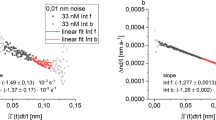Abstract
In ligand binding assays (LBA), the concentration to response data is a nonlinear relationship driven by the law of mass action. Four parameter logistic (4PL) and five parameter logistic (5PL) curve fitting models are two widely accepted and validated models for LBA calibration curve data. Selection of the appropriate regression model and weighting function are key components of LBA development. Assessment of selected model and weighting function should be performed during assay development and confirmed later during validation. There has been limited published work on practical approaches to determining an appropriate weighting function and selection of a regression model for ligand binding assays. Herein, a structured scheme is presented to determine both. By applying commonly available software, assay performance data were analyzed to determine weighting functions and associated choice of a curve fitting model in three presented case studies. As a result, assay ranges of quantification were improved by reducing lower limit of quantification (from 1.00 to 0.317 ng/mL in one case study and from 2.06 to 1.37 ng/mL in another) or extending both low and upper limits of quantification(e.g., 1.04 to 48.3 ng/mL improved to 0.602 to 145 ng/mL). In addition, assay calibration curve performance demonstrated improved assay accuracy (%RE) and precision (%CV). Recommendations on decision flow when determining appropriate weighting function and curve fit model are presented.







Similar content being viewed by others
References
Azadeh M, Gorovits B, Kamerud J, MacMannis S, Safavi A, Sailstad J, Sondag P. Calibration curves in quantitative ligand binding assays: recommendations and best practices for preparation, design, and editing of calibration curves. AAPS J. 2017;20(1):22.
O’Connell MA, Belanger BA, Haaland PD. Calibration and assay development using the four-parameter logistic model. Chemometr and intell lab syst. 1993;20(2):97–114.
Gottschalk PG, Dunn JR. The five-parameter logistic: a characterization and comparison with the four-parameter logistic. Anal Biochem. 2005;343:54–65.
Boulanger B, Devanarayan V, Dewe W. Statistical considerations in the validation of ligand-binding assay. In: Khan MN, Findlay JW, editors. Ligand binding assay: development, validation, and implementation in the drug development arena. New York: John Wiley & Sons; 2010. p. 111–28.
Hawkins DM. The problem of overfitting. J Chem Inf Comput Sci. 2004;44(1):1–12.
ANVISA. Guide for validation of analytical and bioanalytical methods. 2003.
Findlay JW, Dillard RF. Appropriate calibration curve fitting in ligand binding assays. AAPS J. 2007;9(2):E260–7.
Finney DJ, Phillips P. The form and estimation of a variance function, with particular reference to radioimmunoassay. Appl Stat. 1977;26(3):312–20.
Finney DJ. Statistical methods in biological assay. 3rd ed. London, UK: Charles Griffith; 1978.
Box GEP, Hunter WG, Hunter JS. Statistics for experimenters. New York, NY: John Wiley & Sons; 1978.
Finney DJ, Phillops P. The form and estimation of a variance function, with particular reference to radioimmunoassay. Appl Stat. 1977;26:312–20.
EMA. Guideline on immunogenicity assessment of biotechnology derived therapeutic proteins. Committee for medicinal products for human (CHMP), London, UK. 2008.
US FDA. Guidance for industry: bioanalytical method validation, draft guidance, US FDA, center for drug evaluation and research, MD, USA. 2013.
MHLQ. Japan, draft guideline on bioanalytical method (ligand binding assay) validation in pharmaceutical development. 2014.
Carroll RJ, Ruppert D. Transformation and weighting in regression. London: Chapman Hall; 1988.
Lavasseur LM, Faessel HM, Slocum HK, Greco WR. Implications for clinical pharmacodynamics studies of the statistical characterization of an in vitro antiproliferation assay. J Pharmacokinet Biopharm. 1998;26:717–33.
Dudley RA, Edeards P, Ekins RP, Finney DJ, McKenzie IGM, Raab GM, et al. Guidelines for immunoassay data processing. Clin Chem. 1985;31(8):1264–71.
Raab GM. Estimation of a variance function, with application to immunoassay. Appl Stat. 1981;30:32–40.
Findlay JW, Smith W, Lee JW, Nordblom GD, Das I, DeSiva BS, et al. Validation of immunoassays for bioanalysis: a pharmaceutical industry perspective. J Pharm Biomed Anal. 2000;21(6):1249–73.
Acknowledgements
The authors thank Sheldon Leung for numerous discussions. The authors thank Judy Smith, Nicole Duriga and Terry Combs for helpful input.
Funding
This work was funded by Pfizer.
Author information
Authors and Affiliations
Corresponding author
Rights and permissions
About this article
Cite this article
Xiang, Y., Donley, J., Seletskaia, E. et al. A Simple Approach to Determine a Curve Fitting Model with a Correct Weighting Function for Calibration Curves in Quantitative Ligand Binding Assays. AAPS J 20, 45 (2018). https://doi.org/10.1208/s12248-018-0208-7
Received:
Accepted:
Published:
DOI: https://doi.org/10.1208/s12248-018-0208-7




